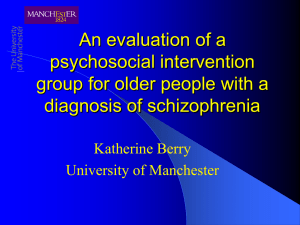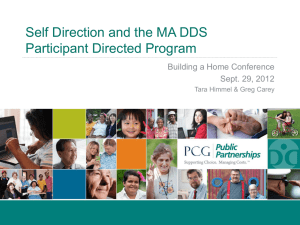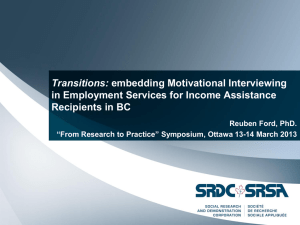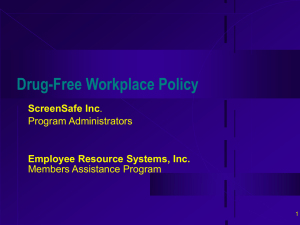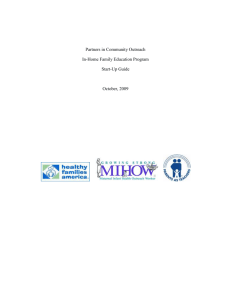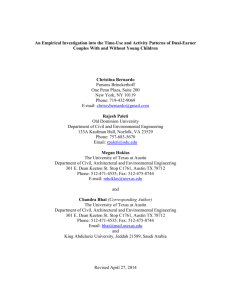NC Innovations In-Home Skill Building and Personal
advertisement
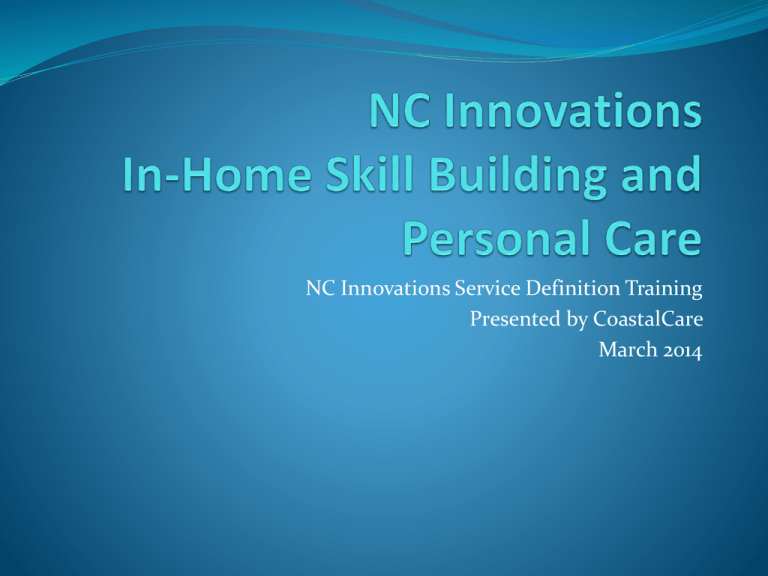
NC Innovations Service Definition Training Presented by CoastalCare March 2014 The Goals of the Waiver Fully integrated members of the community functioning at the individuals maximum level. Community integration through work, lifelong learning, recreation and socialization. Self Sufficiency, Advocacy, SelfDetermination. Leverage all community and natural supports and resources. Quality services and improved outcome measures. Things that are common to ALL waiver services. Prior authorization through the submission of the ISP and documentation of functional needs justifying medical necessity. No specific technique or model Specific service definitions and practice guidelines Designated service delivery locations in definitions Qualifications of staff delivering services Limits/exclusions for individual services and sets of services The role of the Medicaid Provider in Service Delivery Providers are responsible for determining with the team the needs of the person based on the assessment, and ensure the assessment accurately reflects the individuals functional needs. Providers are responsible with the team to determine the appropriate service, frequency and duration they believe needs to be requested. Providers are responsible for hiring qualified staff and training/supervision to meet the unique need. of the person. Providers are responsible for documenting and claiming billing on Medicaid requirements. Providers must follow all waiver policies. The Purpose of In-Home Skill Building • Teaching a NEW skill for individuals living in private homes. (not out of home placements) • Teaching skills to promote independence. • Teaching skills essential to healthcare. • Habilitation Services are the foundation of training and include In Home Skill Building. Other services that include skill building are Day Supports, Community Networking, Supportive Employment, and Residential Support. Definition In Home Skill Building: Provides training in skill building to enable the person to acquire and maintain skills which support independence. Augments/provides additional supports to the person’s family and/or other natural supports. Consists of an array of services that are required to maintain and assist the person to live in community settings. In-Home Skill Building consists of: *Training in interpersonal skills and the development and maintenance of personal relationships. *Skill building to support the person in increasing community living skills (i.e. shopping, recreation, personal banking). *Training with therapeutic exercises; training with selfadministering on medications and other services essential to health care, such as transferring, ambulation and the use of special mobility devices. *Transportation to support implementation of InHome Skill Building. What are Interpersonal Skills Interpersonal skills are the life skills we use every day to communicate and interact with other people, individually and in groups. Listening Skills Communication Skills Stress management Verbal communication Assertiveness Decision Making Problem Solving Non Verbal Communication How do you Train Interpersonal Skills? Preplanned sessions of direct instruction that have plans developed prior to training around new interpersonal skills being developed including social skills to assist with development of meaningful relationships . Includes direct instructions Performance feedback Social reinforcement Modeling, and role-playing Practice What Skill Building is! Structured sessions with plans developed around objectives for each activity. Includes specific instructions for each step developed through a task analysis, with individualized interventions, tools to complete the tasks and timelines for each step. Immediate feedback for each activity and social reinforcement to assist in retention and mastery of skills. Modeling, role-playing, and real life practice What Skill Building is NOT! Disorganized, unstructured activities that are not planned and not consistent between sessions or among staff providing the training. Lacks specific repetitious instructions and steps for each activity. Missing performance feedback and redirection No social reinforcement Practicing skills without development of task analysis, steps and interventions for each step, preparation (anticipatory guidance), route practice with documentation of outcomes/progress. What is Therapeutic Exercise? Bodily movement prescribed to correct an impairment, improve musculoskeletal function, or maintain a state of well-being. Therapeutic exercise seeks to accomplish the following goals: Enable ambulation Release contracted muscles, tendons, and fascia Mobilize joints Improve circulation Improve respiratory capacity Improve coordination Reduce rigidity Improve balance Promote relaxation Improve muscle strength Improve exercise performance and functional capacity (endurance) Therapeutic Exercises training Structured sessions with staff around recommended therapeutic exercises and the steps for each exercise as required by Includes specific activities and recommendations from specialized therapies (OT, PT, ST) or medical practitioners. Continuous performance documentation and consultation with therapists or doctors for input around outcomes. In-Home Skill Building is individualized, specific, and consistent with the person’s assessed disability specific needs and is NOT provided in excess of those needs. Assessed Needs The assessment process determines the feasibility of NC Innovations participation and the need for continued participation. considers the services and supports needed to enable the person to attain an optimal level of independence and self-sufficiency addresses the well-being of the person, including risks in the person’s life that need to be addressed to ensure the person’s health and welfare in the community determines the person's abilities; the help the person needs; the support available from and needed by informal caregivers; the help available from other sources; the person's living situation; and the individual's/responsible party's preferences in regard to care and the best strategy to meet the Life Goals of the person What should an Assessment include? Various evaluations that are applicable to the person’s situation, that are required to determine the person’s needs related to their mental retardation (intellectual disability) or related developmental disability, to live inclusively in their community with maximum independence. Occupational Therapy Evaluation Physical Therapy Evaluation Speech Therapy Evaluation Psychological Evaluation Assessments, continued Assessments should focus on the person’s strengths, abilities and positive steps used to enhance the person’s ability to meet his or her Life Goals, or to help the person determine what Life Goals to pursue. Assessments should also show the barriers to a person’s attainment of his/her Life Goals and be a foundation for determining how to address the barriers. In-Home Skill Building is different from Personal Care by the presence of training. It is anticipated that the presence of In-Home Skill building will result in a gradual reduction in hours as the person is trained to take on additional tasks and masters skills to their optimal functional level. On-going authorization of this service requires the demonstration and documentation of progress. Service Exclusions In-Home Skill Building is furnished in a manner not primarily intended for convenience of the person, primary care-giver(s), or providers. This service IS NOT to be provided in the home of the direct care staff. The service MUST start and/or end at the person’s private home. The person may NOT be also receiving Residential Supports. Service Exclusion – Continued In-Home Skill Building may NOT be provided at the same time of day as Day Supports, Community Networking, InHome Intensive Supports, Personal Care, Respite, Supported Employment, and/or one of the State Plan Medicaid services the works directly with the person. For school-age children, In-Home Skill Building does NOT include transportation to/from school settings, including to/from the child’s home or any other location where the person may be receiving support before or after school. Note: The amount of this service is subject to the Limits on sets of Services. The Purpose of Personal Care • Support, Supervision, and engaging in ADL’s • Maintenance of skills already mastered. • Supervision of independent activities. Definition of Personal Care Personal Care Services under the waiver include support, supervision engaging participation with eating, bathing, dressing, personal hygiene and other activities of daily living. Support and engaging the participant describes the flexibility of activities that may encourage the participant to maintain skills gained during habilitation while also providing supervision for independent activities. This service may include preparation of meals, but does not include the cost of the meals themselves. Definition of Personal Care When specified in the ISP, this service may also include housekeeping chores such as bed making, dusting and vacuuming, which are incidental to the care furnished or which are essential to the health and welfare of the participant, rather than the participant’s family. Personal care also includes assistance with monitoring health status and physical condition, assistance with transferring, ambulation, and use of special mobility devices. Personal Care Services may be provided outside of the private home as long as the outcomes are consistent with the support described in the ISP. Services may be allowed in the private home of the provider, staff or an Employer of Record, or staff of an Agency With Choice if there is documentation in the ISP that the participant’s needs cannot be met in the participant’s private home or another community location Personal Care Exclusions Does not include medical transportation and may not be provided during medical transportation and medical appointments. Participants, who live in licensed residential facilities, licensed AFL homes, licensed foster homes, or unlicensed alternative family living homes serving one adult, may not receive any aspect of this service or any other State Plan Personal Care Service. Personal Care cannot be provided in a licensed program. This service may not be provided on the same day that the participant receives State Plan Medicaid Personal Care Services, a home health aide visit, Residential Supports or another substantially equivalent service. Transportation between the participant’s home and the provider’s home is not billable service time Personal Care Exclusions, continued This service may not be provided at the same time of day that a participant receives Day Supports, Community Networking, In-Home Intensive Support, In-Home Skill Building, and Respite, Supported Employment or one of the State Plan Medicaid services that works directly with the person. The service does not cover the staff member completing home maintenance, housekeeping for areas that are used by other members of the household and/or meal preparation when the same meal is being prepared for other family members. For participants who are eligible for educational services under the Individuals With Disability Educational Act, personal care does not include transportation to/from school settings. This includes transportation to/from the participant’s home, provider home where the participant may be receiving services before or after school or any other community location where the participant may be receiving services before or after school. Comparison of In Home Skill Building and Personal Care In-Home Skill Building Personal Care Requires assessed needs Does not have to be instruction of new Requires assessed needs Structured Requires specific Instruction Continuous Performance feedback Social reinforcement Modeling, and role-playing Practice Must start in and end the home Gradually reduces in hours as progress is made skills Assist person as they need assistance Occurs naturally throughout the service Encouragement to participate Can be delivered in setting including the community, but not licensed facilities, school or hospitals. Can start and end anywhere; but cannot be provided in a licensed facility, school or hospital. Hours of support generally do not decrease over time, but can decrease with needs changing, implementation of a behavior plan, addition of assistive technology. Cannot start or end at school What can you expect from CoastalCare? In-Home Skill Building will be assessment driven and outcome oriented. will need to show progress during an authorization period or will need new assessment and revised goals, interventions and strategies. (provider quarterly progress summaries and daily grids will be crucial for documentation of progress/outcomes and determining recommendations for continuation, reduction or termination of an outcome) is viewed as a service to be delivered over a individual period of time to address new skills for individuals that have the capacity to develop for specific outcomes and fade as mastery is obtained. Individuals who receive this service will need to demonstrate the functional capacity and level of readiness to obtain the skills outlined in the ISP as evidenced by ongoing assessments. PCS will be viewed as a support service that includes supervision that does not have a fading expectation. Time for Questions??? Teaching skills first means you must understand how to make the training “ergonomically sound”. At its simplest definition ergonomics literally means the science of work. So ergonomics is the study of work/tasks, how work is done and how to work better. To do this you must understand 3 things: 1. Body Mechanics 2. The tool being used 3. The task being performed When Providers write short term goals for InHome Skill building for Teaching a NEW skill to individuals Its important to match the task to the adaptive functional need. It is important to create a “task analysis”. A task analysis is a document where the instructor breaks down a task into it’s component parts. The component parts or steps often start as repetitious and time consuming tasks, but the steps can be adjusted and interventions designed to match the participant’s skill level. Individuals with strong receptive language skills may be able to respond to verbal prompts as an intervention, while individuals with poor fine motor skills may need more discrete steps or modifications including adaptive equipment or a unique way to complete the task independently. Task Analysis is used to break down a variety of tasks in the steps to complete the work or activity. Example “A Task Analysis for Tooth Brushing” 1. Remove cap from tooth paste and set on the counter to left of sink 2. Turn on cold water 3. Take brush in right hand, holding bristles up, with right thumb up 4. Wet the brush under the running cold water 5. Squeeze toothpaste onto tooth brush 6. Place toothbrush with bristles against the right rear molars on the top, and move bristles up and down from back to front. 7. Repeat on left top. 8. Move to the right bottom and left bottom. Repeat the up and down brushing. 9. Spit saliva and toothpaste into sink after each quadrant. 10. Rinse out the brush with water and replace in holder/case. 11. Fill glass with water 12. Fill mouth with water, swish around and spit into sink. Task Analysis also identifies the tools to complete the task and the amount of time each step will take to complete the work or activity. Example for “Brushing your Teeth” Tools: toothbrush, toothpaste, water source(faucet), sink, glass, towel. Time: 1. 2. 3. 4. 5. 6. 7. 8. Unscrew toothpaste cap (15 seconds) Squeeze toothpaste onto toothbrush bristles (15 seconds) Turn on faucet (5 seconds) Wet toothbrush (2 seconds) Brush teeth (120 seconds) Fill glass with water (3 seconds) Rinse mouth and spit into sink (6 seconds) Turn off faucet and dry mouth and hands with towel (8 seconds) If needed steps can be broken down further to elemental actions to perform a task called “Critical Task Analysis”. Critical is defined as necessary for success. In brushing your teeth the steps involving toothpaste and brushing are “critical”. If you cannot unscrew the cap you cannot get to the toothpaste, which means you cannot brush your teeth, which means you cannot complete the task. Rinsing your mouth and drying your hands are not critical to completing the task. Once the Task Analysis is completed the instructor will decide how to support the instruction. The support could be: Hand-over-hand assistance Modeling Verbal prompting Back-ward chaining Forward chaining with instruction Instruction with the use of adaptive equipment These will be individualized based on the persons needs so the instruction personalized for success and the individual can independently complete the task. Instruction and progression with mastery of a new skill should be documented for each step The daily grid should document each step, type of support or intervention, time required, and progress in a very systematic way-not flowing naturally but in a organized, methodical manner. Instruction should also be time limited before mastery of the skill, or change in the task, or change in the support/intervention occurs. If complete mastery of the task is not attainable due to functional limitations even with appropriate supports training of the new skill may appropriate. Helpful links for tasks analysis Helpful links for Task Analysis National Secondary Transition Technical Assistance Center http://nsttac.org/content/evidence-based-practicessecondary-transition Exceptional Children Assistance Center http://www.ecac-parentcenter.org/ More Time for Questions??



